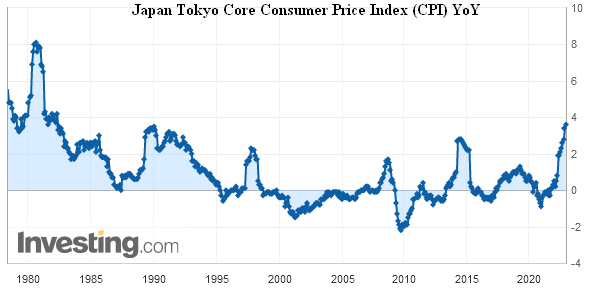November 19-25, 2022
Big news. Due to the Thanksgiving Day this week in USA was short. And the main events were the discussion of the maximum price for Russian oil and the recognition by the European Parliament of Russia as a sponsor of terrorism. The meaning of the latest event is that in Western banks an operation is being prepared to confiscate Russia’s reserves frozen in February, after the start of a special military operation in Ukraine. In addition, this status allows the confiscation of any assets of Russian citizens.
Thus, both events are precedents that completely destroy the model of capitalist interaction that has been operating over the past centuries. Yes, of course, the United States and a number of other countries have acted this way before (for example, with the assets of Iran and Venezuela), but in this case the scale becomes prohibitive for the system as a whole. There is no doubt that in a normal situation this was impossible (the history of interaction between the USA and the USSR is an example of this). Therefore, one must be aware that such actions, in themselves, regardless of their consequences, mean that their organizers do not believe that it is possible to restore the previous system!
Actually, the return of the “Western” economic system to the borders of AUKUS (USA, Canada, Great Britain, Australia and New Zealand) with the liquidation of the economic system of the European Union is already being widely discussed. But what happened this week showed, firstly, that this decision has most likely already been made. Secondly, that the current leadership of the EU already understands its fate and is trying to find resources to somehow survive in the coming chaos (although it does not have any strategic plan). And, thirdly, that the current leadership of the EU does not have political subjectivity.
And all this is economic news, because it speaks of the strategic direction of the actions of various forces in the world. In particular, it can almost certainly be said that the elite of the “Western” global project (which today is behind both the “Biden team” and the leadership of the EU), international bankers, are in for extremely difficult times.
Macroeconomics. The balance of industrial orders in Britain is in the red for 4 months in a row:

PMI (an expert index of the state of the industry; its value below 50 means stagnation and recession) of most countries of the world remain in the recession zone, both in manufacturing and in the service sector.
in Australia:


in Japan:


in the Eurozone:


in the UK:


in the USA:


And this situation allows us to confirm our recent assumption about the intensification of crisis processes in the global economy. Before that, one or another country broke into a positive area, now the picture is almost the same. Well, let’s not forget that all this against the backdrop of low inflation.
The National Activity Index in the US from the Chicago Fed has gone negative again:

The Richmond Fed Regional Industry Index has not gone positive for 7 months in a row:

And for the service sector – 6 months:

Leading indicators in Japan are at their lowest in 2 years:

And in Argentina, they have been declining for 3 months in a row:

Business confidence in Turkey weakest since June 2020:

And in France – from March 2021:

Current business conditions in Germany – from February 2021:

Canada Business Barometer – April 2020:

CPI (Consumer Inflation Index) in the Japanese Prefecture of Tokyo +3.8% per year – the highest since 1991:

And without fresh food (+3.6% per year) – even since 1982:


“Net” (excluding highly volatile food and fuel components) CPI in Mexico +8.7% per year – the highest since 2000:

PPI (industrial inflation index) in Germany -4.2% per month – a record decline in 73 years of observation:

And this is not a positive signal, it is a powerful deflationary symptom, a sign of the beginning degradation of the real sector.
Mexico retail sales -0.2% per month – 2nd negative in a row and 3rd in 4 months:

Canada -0.5% per month:

U.S. initial jobless claims at 3-month peak:

And repeat claims for more than 8 months:

As we have already noted more than once, this indicator by itself does not mean anything, it is too distorted. But if it demonstrates stable dynamics for several months in a row, it most likely means that it coincides in direction with real processes.
The Central Bank of New Zealand raised the rate by 0.75% to 4.25%, They promised to continue. Central Bank of South Africa – also by 0.75%, up to 7.00%. The Central Bank of South Korea raised the interest rate by 0.25% to 3.25%.
The Central Bank of China left its monetary policy unchanged, the Central Bank of Turkey lowered the rate by 1.5% to 9.0%. Turkey defiantly ignores the logic of the IMF.
Main conclusions. In part, we have already voiced them – the scale of the crisis is growing. And its structural character is also becoming more and more evident. You can give, for example, a graph of the share of energy expenditures in the structure of GDP for OECD countries:

The question here is not in what direction the dynamics are, it is important that the structure of the economy is changing dramatically. The only analog comparable in scale is the “oil shock” of the 70s. But then the changes concerned only the oil sector, now – almost the entire economy. At the same time, neither the IMF, nor the FRS, nor expert institutions currently have models that could describe the scale of these structural changes, show what the structure of a post-crisis economy might look like.
The only exception is the Mikhail Khazin Foundation for Economic Research, which has been dealing with this subject since its foundation in 2015. We note that the development of such models without an adequate theory of the crisis seems to be quite meaningless. Partially, the results of our modeling are reflected on the Foundation’s website, but, if necessary, they can be significantly expanded and deepened. To implement such requests, we have created a special structure, the Agency for Strategic Forecasting “Ark” (https://strategic-ark.com), where we invite those who are concerned about relevant issues to contact.
During the week, the minutes of the FRS meeting on November 1-2 were published. Basic moments:
Majority of Fed officials support slowdown in rate hikes in the near future
Participants noted that the situation on the labor market remains tense; many noted tentative signs that it may be gradually moving towards a better balance of supply and demand.
Participants agreed that there were few signs of easing inflationary pressures.
Participants agreed that a slower pace of rate hikes would allow the FOMC to better assess progress towards its targets, “given uncertain delays” associated with monetary policy.
As monetary policy approaches “rather restrictive” levels, participants stressed that the final destination of the federal funds rate has become more important than the rate itself.
Several participants suggested that a slowdown in rate hikes could reduce financial system risks, others suggested that a slowdown should wait for more progress on inflation.
All participants agreed that the 75 bps increase was necessary and was the next step towards making monetary policy sufficiently restrictive.
Participants agreed that risks to the inflation outlook remain skewed to the upside.
Some participants said that a more stringent policy was consistent with risk management, while others noted an increasing risk of over-delay.
Participants noted that the labor market remains tight, with many noting early signs that it may be gradually moving towards a better balance of supply and demand.
Many participants expressed considerable uncertainty about the final level of the Fed funds rate needed to contain inflation, with various participants suggesting that it was higher than previously expected.
Participants noted that, despite increased interest rate volatility and signs of tight liquidity conditions, the Treasury securities market functioned in an orderly manner.
The Fed discussed market resilience in light of the turmoil in the UK.
Most Fed officials support a slowdown in rate hikes in the near future.
Several Fed officials predicted that interest rates would peak at a higher level.
In fact, two conclusions can be drawn. The first is that participants realize that the rate will need to be raised very high to reduce inflation. Including because inflation reacts poorly to the tightening of monetary policy.
Secondly, I really want positive changes to happen by themselves, and therefore it’s still not worth rushing to raise the rate, suddenly a miracle will happen … Note that the data on the total volume of industrial goods in October showed clearly optimistic results, however, at the time of the Fed meeting they were not known yet.

Total industrial inflation is slightly above 10% (and half a year ago it was more than 23%) – this is a very good result; it would seem that there is nothing to worry about. But there is one very dangerous nuance. The data of the previous section show that the US industry is stagnating, and in this situation, a decrease in inflation can be a serious sign of beginning deflationary processes (as in Germany)!
Recall that the crisis of 1929-32. began after the Fed launched a monetary contraction program (in order to somewhat limit the overheated stock market). Now the monetary contraction is a record (chart from Pavel Ryabov, Spydell):

And in this regard, we can assume that the leadership of the Fed is afraid of repeating the old scenario.
Recall that we believe that the analogue of the structural crisis of 1930-32 already started a year ago and, moreover, the US economy is also in recession. But since, unlike the situation almost a century ago, it follows an inflationary rather than a deflationary scenario, the collapse of the markets that occurred in 1929 has not happened yet. Well, the underestimation of inflation rates allows you to hide the recession that has begun in nominal figures. However, it still manifests itself, as can be seen from macroeconomic indicators. Well, if the monetary contraction continues, it can easily “fall” into the scenario of the early 30s.
In general, good, of course, is not enough, but our readers can be calmer, because they know the real state of affairs. And we wish them a good weekend and a successful working week.

